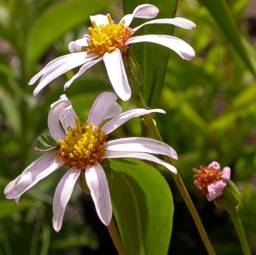Aster laevigatus
Aster laevigatus (Sond.) Kuntze
Family: Asteraceae
Common names: Van Staden's aster
Introduction
Aster laevigatus is a little, white to mauve daisy first discovered in the early 1900's. Only a single specimen was taken to London and preserved in the Kew Gardens herbarium and it was thought to be extinct until its rediscovery in 2006.
Description
Description

A compact glabrous perennial growing to a height of 300 mm. The leaves are oblanceolate with 3 to 5 veins that run from the base. It has radiate flower heads, common in its genus, the flower heads are solitary and have white to mauve rays and a yellow disc in the centre.
Conservation Status
Status
The Van Staden's aster is listed as Vulnerable on the South African Red List.
The species was thought to be extinct until 2006 when seedlings appeared after an accidental fire. These plants flowered and produced seed. There was a natural decline in the number of flowering plants a few years after the initial fire, but seedlings have been seen in 2008. In situ conservation - The presently known populations of Aster laevigatus are being monitored by conservation officers at Van Staden's Nature Reserve.
Major threats to the species are the clearing of natural veld for the establishment of plantations of pine and too frequent bush fires. Ex situ conservation - Seeds of this species are currently preserved in the Millennium Seed Bank, and plants are being grown at Kirstenbosch in their display collection. Some plants have also been planted in the display garden at Van Staden's Wild Flower Reserve.
Distribution and habitat
Distribution description
Aster laevigatus was once common in the Van Staden's area, however, due to human habitation and agriculture, the species is now limited to southeastern slopes of the Van Staden's Mountains. It grows in the grassland biome, in rich loamy soils that are well drained. It grows close to the coast within the area that is cooled by on-shore sea breezes.
Derivation of name and historical aspects
History
The family name Asteraceae is made up of the name Aster and the suffix -aceae. The inclination in taxonomy is to use the name of a familiar plant belonging to the family. Aster is the Greek word for star, which refers to the flower heads' star-like appearance. In ancient times people believed that asters were created from stardust when Virgo (also known in Greek mythology as Astrea "the starred one"), looked down from the heavens and cried as she was the last immortal to live amongst men on earth.
It is also believed that burning the flowers of asters drives snakes away from the home. The Latin word laevigatus means smooth, and pertains to the glabrous nature of the plant.
There are approximately 250 species of Aster, which occur mainly in the northern hemisphere. Some 17 species are indigenous to South Africa and one is a naturalised species.
Ecology
Ecology
This species appears to require fire to clear dense vegetation every few years in order for mass germination and flowering to occur. It is pollinated by bees and other insects attracted to the yellow central disc of the flower head. Flowering takes place in October and "seeds" (fruit) are harvested in January and early February.
Uses
Use
Asters in general have been used worldwide, traditionally as medicines, especially herbal ones (i.e. echinacea), and in a few instances as food. Although Aster laevigatus has no uses many asters can be used as a dye; the stems, leaves and even flowers of asters will produce a brassy gold dye when mixed with a chrome mordant, greenish-gold with a copper mordant, bright yellow-gold with a tin mordant, dark grey-green with an iron mordant and a yellow-green with no mordant. The colours can be quite striking and do not fade in light.

Growing Aster laevigatus
Grow
This Aster can be grown in pots or as part of a perennial border in the garden. Sow Aster seeds early in the spring, and cover lightly with soil. Sow onto sterile finely milled pine bark and cover lightly with river sand. Apply a solution of water and fungicide and water it thoroughly to prevent damping-off of seedlings. Soil mixtures should be moist, but not wet. The plants will withstand dry periods, however, not for prolonged periods. Water them during hot dry periods once or twice per week to keep growth vibrant. The seeds germinate easily and will grow quickly, producing the first blooms by mid-summer. A suitable potting medium consists of 6 parts compost, 1 part loam, 2 parts riversand and 2 parts bark.
Aster laevigatus can be grown using the propagation technique of division. Plants do best if divided every two to three years. Divide clumps into two or three portions and replant in new soil. It is best to feed these plants during the growing period once a month with an organic fertilizer. Asters are somewhat resistant to insects and diseases, but if problems do occur, treat plants early with organic or chemical insect repellents and fungicides.
References
- Burrington, Wesley (Van Stadens Wild Flower Reserve) pers. comm.
- Emanoil, M. (ed.). 1994. Encyclopedia of endangered species: 1136. IUCN, The World Conservation Union, Detroit.
- Goldblatt, P.& Manning, J. 2000. Cape Plants. A conspectus of the Cape flora of South Africa. National Botanical Institute, Cape Town and Missouri Botanical Garden.
- Smith, C.A. 1966. Common names of South African plants. Memoirs of the Botanical Survey of South Africa No. 35.
Credits
Carly Cowell
Kirstenbosch National Botanical Garden
May 2010
Plant Attributes:
Plant Type: Perennial
SA Distribution: Eastern Cape
Soil type: Loam
Flowering season: Spring
PH:
Flower colour: White, Yellow, Mauve/Lilac
Aspect: Full Sun
Gardening skill: Average
Special Features:
Horticultural zones











Rate this article
Article well written and informative
Rate this plant
Is this an interesting plant?
Login to add your Comment
Back to topNot registered yet? Click here to register.